Unusual Hardy Aroids—Tropical-Looking Beauties for the Northern Gardener
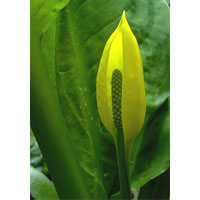
If I had to pick my favorite plant family, I think it would be the Araceae, or aroid family (also called the philodendron family or arum family). The species in this family have such bold, striking foliage and bizarre, interesting flowers. Where I reside, in frost-free Vieques, Puerto Rico, I can cultivate magnificent tropical aroids like Anthurium, Syngonium, Alocasia, and Monstera—common houseplants in the States—outdoors to my heart's content. But what aroids can be grown outside in more temperate climates? If pressed to name some, most gardeners would list the beloved jack-in-the-pulpits (Arisaema species) and the eastern North American skunk cabbage (Symplocarpus foetidus) and end there. Fortunately, though, there are numerous other cold-hardy aroid species available, most of them coming from Europe, the Mediterranean, and Asia.
But before learning about some of these species, we need to familiarize ourselves with the two main features of aroid floral anatomy: the spathe (plural: spathes) and the spadix (plural spadices). These two structures are the calling cards of the Araceae and are often misunderstood. People commonly mistake the inflorescences of aroids for single flowers—think of the very popular aroid calla lily (Zantedeschia aethiopica) and its funnel-shaped white "flower." However, the elegant "petal" of an aroid is a modified leaf called a spathe, and the slender column protruding from the spathe—the spadix—is actually a collection of hundreds of individual, petalless flowers. The flowers can be male or female, or both, depending on the species.
In addition to learning the floral terms, we also need to prepare ourselves for the pong! All aroids are insect pollinated and have evolved ingenious ways of attracting bugs. Some genera use sweet perfumes to lure pollinators, but most are serviced by flies, dung beetles, fungus gnats, and midges, which prefer their perfumes a little more on the sour side. The spadices of these aroids exude smells that chemically mimic manure, carrion, rotten vegetables, or mushrooms. The aroid spadix is quite the evolutionary marvel: In addition to producing scent, it has the ability to raise its temperature to enhance the fragrance and create a microclimate in which insects are more active and thus better pollinators. Some aroid odors are amazingly powerful, but since the biology is so fascinating—and the plants are so beautiful—I feel that a little nasal discomfort is a small price to pay for having them around. And besides, the inflorescences are short lived.
Following are some of my favorite hardy arums. They are generally pest free—and it's no wonder: Their foliage is chock-full of a potent mixture of oxalic and hydrocyanic acids, calcium oxalate crystals, and saponins. Due to this chemical cocktail, gardeners with sensitive skin should avoid direct contact with the juice of the foliage and skin of the tubers and rhizomes.
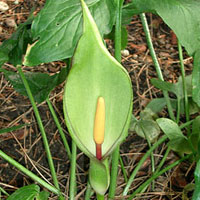
Arum italicum (Italian arum)
Like many hardy arums, this European and North African native has a topsy-turvy growing cycle: In summer, when most plants are in full leaf, its foliage is dormant; in the fall, when everything else is winding down, it sends up 14-inch-long, arrowhead-shaped, silver-veined green leaves that persist through the winter. In late spring, 6- to 16-inch-long greenish-white spathes appear out of the ground enveloping short, yellowish spadices that emit a manurelike odor, which attracts midges. The inflorescences develop into spikes covered with bright orange-red berries that can last until the foliage returns again in the fall. Hardy from USDA Zones 6 to 9, Italian arum can be propagated by seed (sown in the fall) or tuber (planted four inches deep in the spring or fall). Ideally, the plant should be grown in humus-rich, well-drained soil in a protected, open woodland locale. Notable cultivars include 'Jet Black Wonder', which grows to a foot tall and bears black petioles and uneven black spots on the leaf blades; 'Marmoratum', which has glossy pale green leaves with cream-colored venation; and 'Silver Cloud', which offers lime-green spathes and patterned silver foliage edged in green.
Arum creticum
This sun-loving and sweet-smelling species is found throughout Greece—especially on the islands of Crete, Kárpathos, and Kasos—and southwest Turkey. A tuberous perennial hardy from Zones 7 to 9, it produces six- to ten-inch-long yellow spathes in spring. The tips of the spathes bend backward elegantly to reveal long, slender, mustard-yellow spadices. The growing cycle of the plant is similar to that of Italian arum, with the foliage coming up in fall. This arum's arrowhead-shaped leaves are a little shorter (seven to ten inches long) than those of Arum italicum, though, and are uniformly dark green. Propagation techniques are the same, but the cultural requirements differ: A. creticum needs fertile, well-drained soil and full sun. Site the plant near garden paths or near a garden seat so admirers can fully partake of the delicious perfume.
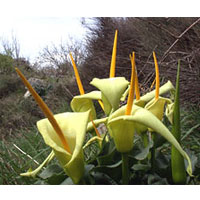
Biarum species (half arum)
The intriguing aroid genus Biarum is made up of about 15 low-growing tuberous species native to open dry ground and rock crevices in the Mediterranean. These species produce small, hooded spathes at ground level in early summer or in the fall prior to the appearance of their foliage, which varies in shape and persists throughout the winter. Although some species have a sweet bouquet, the hardiest members of the genus boast fetid-smelling inflorescences that attract carrion and dung beetles as pollinators. The fruit clusters that develop are white or pale green. Biarum bovei, native to Italy and Sardinia, is one of my favorites species and is hardy from Zones 7b to 8. It produces two-inch-tall, foul-smelling, dark purple-backed spathes and erect dark-purple spadices. When in leaf, the plant resembles a tiny green hosta. Another favorite is B. tenuifolium, native from Sicily to western Turkey. It bears narrow, four- to eight-inch-tall purple-flushed pale green spathes and slender, black, nasty-smelling spadices. The species is hardy from Zones 7 to 9. Biarum seed may be sown when temperatures reach 55°F; tubers can be divided and planted in summer (two inches deep). Ideally, the soil should be sharply drained and scree-like and should remain hot and dry during the summer dormancy period. Add plenty of sharp sand or turkey grit if the soil seems too heavy. Try culturing Biarum against a south-facing rock wall or a boulder in the rock garden to maximize heat.
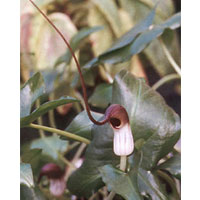
Lysichiton species (skunk cabbage)
The genus Lysichiton is made up of two wetland perennial species: Lysichiton americanus (yellow skunk cabbage, or swamp lantern), native to western North America, and L. camtschatcensis (white skunk cabbage), native to northeastern Asia. (These species are distinct from the eastern skunk cabbage—Symplocarpus foetidus—mentioned above). The yellow skunk cabbage is the larger of the two, producing rosettes of two- to four-foot-long, glossy, strongly veined green leaves in spring. In early spring, before the foliage appears, 1½-foot-long bright yellow spathes emerge at soil level. The perfume released by the spathes (not the spadices, as with other genera) is reminiscent of rotten, overcooked Brussels sprouts, and it attracts beetle pollinators. Hardy from Zones 6b to 9, yellow skunk cabbage looks wonderful beside a stream or pond or in a medium to large bog garden with fertile, humus-rich soil. Its far-eastern cousin, the white skunk cabbage, is only slightly smaller and has similar foliage and cultivation requirements. The spathes are just as long as well but (you may have guessed already) are pure white. The plant is hardy from Zones 7 to 9. A new hybrid of the two species is available from Heronswood Nursery (see "Nursery Sources"), and it is touted as having more vigor and a blend of the parents' characteristics—such as creamy white spathes.
Arisarum proboscideum (mouse plant)
This charming little plant is a must for anyone introducing children to the joys of horticulture. A rhizomatous perennial native to Spain and Italy, it produces a mat of 2½- to 6-inch-tall arrowhead-shaped dark green foliage. In spring, small, hooded, brown-purple spathes appear amid the leaves, each bearing a six-inch-long curled, filamentous lip or "tail." They look like families of mice ducking for cover in the greenery. Who could resist? This aroid has also evolved an unusual technique to ensure pollination—it imitates a mushroom. Its insect pollinators are fungus gnats, and not only do the plants blossom simultaneously with the first springtime flush of fungus gnats, but their spathes contain gill-like structures that resemble the underside of mushroom caps and even emit a faint mushroomy smell. In humus-rich soil and partial shade, the mouse plant can form large colonies that are easily increased through division of the rhizomes during the fall or winter dormancy period. It is hardy from Zones 6 (in a protected site) to 9.
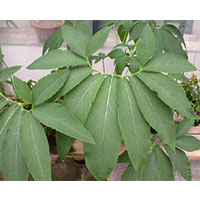
Sauromatum venosum (voodoo lily)
This tuberous aroid, hailing from the Himalaya, is considered to be subtropical (tolerating a minimum temperature of 41°F) and technically has no place here, but I am including it because I cultivated a four-foot-wide colony of it in Columbus, Ohio (Zone 6), through decades of freezing hibernal Midwest temperatures. It could prove hardy for you too! Considered a horticultural novelty, the voodoo lily tuber will produce its purple-mottled shiny green spathe and purple-brown spadix on a windowsill even without soil or water. The early-spring inflorescence grows up to 15 feet tall and emits a profoundly strong smell of carrion. (When I grew the plant, it attracted every fly in the neighborhood. "Did one of your cats die?" a neighbor inquired.) After its inflorescence fades, each tuber produces a single dark green, two-foot-tall leaf divided into numerous lance-shaped segments. The leaves have puce leopard spots on their petioles, and in large clumps they make an impressive tropical foliar display. By midsummer, the foliage shrivels away, but in fall, clusters of attractive red berries appear. The tubers multiply rapidly, making propagation from offsets easy. Plant the tubers six inches deep in fertile, well-drained soil and partial shade. With adequate protection in the colder areas, the voodoo lily can be hardy from Zones 6 to 9.
Nursery Sources
Heronswood7530 NE 288th Street
Kingston, WA 98346
360-297-4172
www.heronswood.com Odyssey Bulbs
P.O. Box 382
South Lancaster, MA 01561
877-220-1651
www.odysseybulbs.com Plant Delights Nursery, Inc.
9241 Sauls Road
Raleigh, NC 27603
919-772-4794
www.plantdelights.com Sunshine Farm and Gardens
HC 67 Box 539 B
Renick, WV 24966
304-497-2208
www.sunfarm.com Telos Rare Bulbs
P.O. Box 4147
Arcata, CA 95518
www.telosrarebulbs.com


